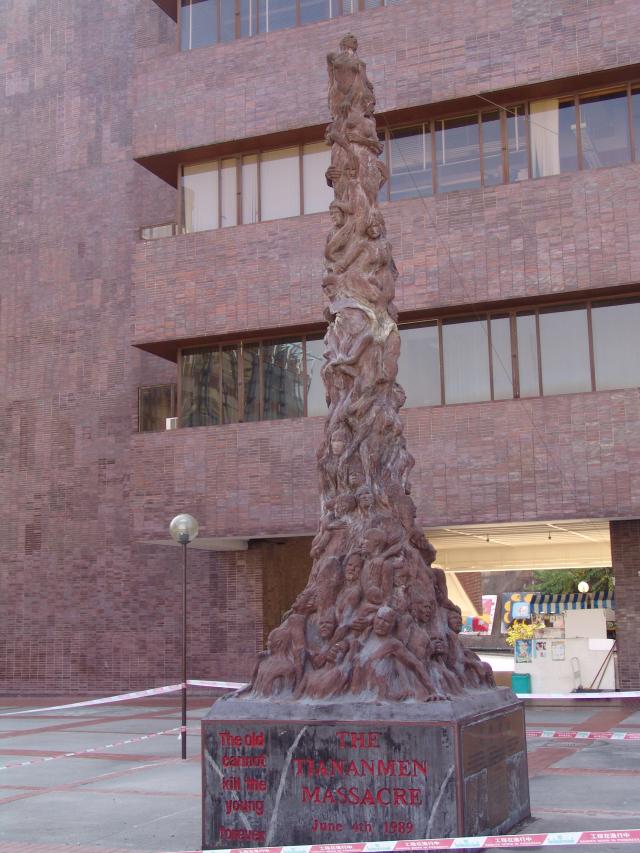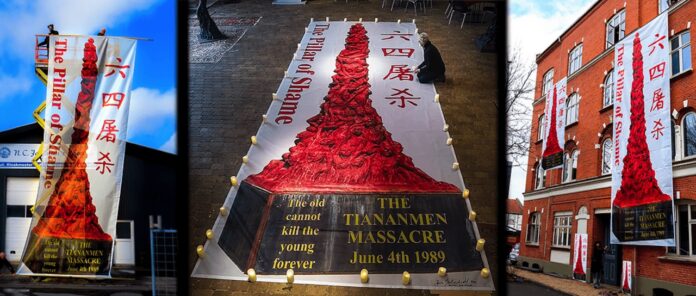June 4, 1989, Tiananmen. The square in Beijing becomes the symbol of Chinese protest. The students protest in favour of freedom and against the strong regime. But they are put down with weapons and tanks ready to crush their demonstration The guns kill at least a thousand. The hope of the new Chinese generation is dashed.
The Pillar of Shame
Lest we forget what happened thirty-four years ago, forty cities around the world joined the “Pillar of Shame” Banner Manifestation. It is an awareness campaign to fix in mind the blood massacre of 1989. The starting point was the Danish sculptor Jens Galschiøt. In 1997, he created the work “The Pillar of Shame” for the city of Hong Kong – painted orange as part of the project The Color Orange of 2008. The first example of the “Pillar of Shame” is in Rome, at the Ostiense Air Terminal where it was put up in 1996.
In 2021, the police removed the work from the University of Hong Kong campus and transferred it into a container before seizing it on May 5, 2023. Since the removal, the artist has granted permission to reproduce the 3D printed work. Also, since then many copies have been circulating around the world.
Jens Galschiøt not only was never intimidated, in addition he stated – as reported by the South China Morning Post – that the kidnapping is an “act against the Democratic Movement in Hong Kong”. The sculptor then started the initiative “The Pillar of Shame Banner” with which he asked anyone to share this symbol of the campaign.
Jens Galschiøt initiative
Galschiøt’s initiative kicked off in early May with demonstrations in various places: in the USA (New York, Washington, Los Angeles, San Francisco, Boston), Canada, Japan, Korea, Taiwan, New Zealand and Australia. Some European countries have been also involved: the Czech Republic, Poland, Germany, France, the United Kingdom and Denmark.
Hong Kong is where, historically, commemorations of Tiananmen Square are more heartfelt than anywhere else. Supporters of civil rights and freedoms gather in Victoria Park, light candles re-proposing the tragic performances of the massacre. But since 2020 everything has been banned due to the Covid-19 pandemic. But now, Victoria Park reopens. Over the first days of June, the commemoration park and the neighboring area of Causeway Bay are transformed into a large fair. Focus on shopping. But the new organizers seem to have forgot the June four 1989 event.
Democracy requires attention
So this year the Chinese student protests crushed by the PLA (Chinese People’s Liberation Army), are remembered only outside China. We welcome, then, the mobilization that the Danish Jens Galschiøt has set in motion: it is a way of not forgetting that democratic values are not acquired forever. Democracy requires attention. The gaze of the peoples must always be alert to the details and every slightest restriction of rights is an alarm signal, one of the “pillars of shame”. An excellent combination of art and activism in defense of the human rights.
Quattro giugno 1989, Tienanmen. La piazza di Pechino diventa il simbolo della protesta cinese. Gli studenti chiedono libertà di espressione e nei comportamenti sociali contro i rigori eccessivi del regime. La loro contestazione è sedata con le armi con carri armati pronti schiacciare i manifestanti. I fucili che ne uccidono almeno un migliaio. Si vanifica la speranza della nuova generazione cinese.

The Pillar of Shame
Per non dimenticare quanto avvenuto trentaquattro anni fa, quaranta città mondiali hanno aderito alla “Pillar of Shame” Banner Manifestation. La campagna di sensibilizzazione per non dimenticare il massacro di sangue del 1989 parte dallo scultore danese Jens Galschiøt. Egli nel 1997 realizza l’opera “The Pillar of Shame” per la città di Hong Kong – dipinta di colore arancio nell’ambito del progetto The Color Orange nel 2008. Il primo esemplare del “Pillar of Shame” è a Roma, all’Air Terminal Ostiense dal 1996.
Nel 2021 la polizia rimuove l’opera dal campus dell’Università di Hong Kong e la sposta in un container per poi sequestrarla il 5 maggio 2023. Dal momento della rimozione l’artista ha concesso l’autorizzazione di riprodurre l’opera stampata in 3D. E da allora molte copie dell’opera circolano nel mondo.
Jens Galschiøt non si fa intimidire e inoltre afferma – come riportato dal South China Morning Post – che il sequestro è un “atto contro il Movimento Democratico ad Hong Kong”. Lo scultore apre, quindi, l’iniziativa “The Pillar of Shame Banner” con la quale chiede a chiunque di condividere questo simbolo della campagna.
L’iniziativa di Jens Galschiøt
L’iniziativa di Galschiøt ha preso avvio ai primi di maggio con manifestazioni in vari luoghi: in Usa (New York, Washington, Los Angeles, San Francisco, Boston), Canada, Giappone, Corea, Taiwan, Nuova Zelanda e Australia. Coinvolti anche alcuni Paesi Europei: Repubblica Ceca, Polonia, Germania, Francia, Regno Unito e Danimarca.
Hong Kong è il luogo nel quale, storicamente, le commemorazioni di piazza Tienanmen sono più sentite che altrove. I sostenitori dei diritti civili e delle libertà si ritrovano a Victoria Park, accendono candele riproponendo le tragiche performance del massacro. Ma dal 2020 tutto è stato vietato a causa della pandemia da Covid-19. Quest’anno, dopo 3 anni di divieti, Victoria Park riapre. Ma dal 3 al 5 giugno il parco della commemorazione e la limitrofa zona di Causeway Bay, si trasformano in una grande fiera. Focus sullo shopping. Ma i nuovi organizzatori sembra non abbiano pensato all’evento del 4 giugno 1989.
La democrazia richiede attenzione
Dunque, quest’anno le proteste studentesche cinesi stroncate dalla PLA (Chinese People’s Liberation Army), sono ricordate solo fuori dalla Cina. Ben venga, allora, la mobilitazione che il danese Jens Galschiøt ha messo in moto: è un modo per non scordare che i valori democratici non sono acquisiti per sempre. La democrazia richiede attenzione, equilibrio. Lo sguardo dei popoli deve sempre essere vigile ai dettagli e ogni minima restrizione dei diritti è un segnale di allarme, uno dei “pilastri della vergogna”. Un ottimo connubio tra arte e attivismo in difesa dei diritti umani.








